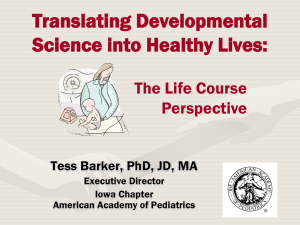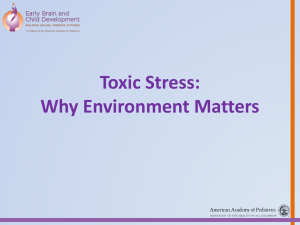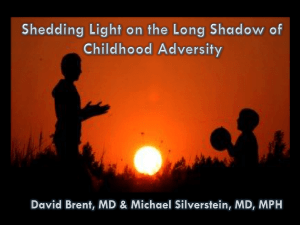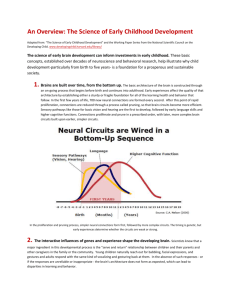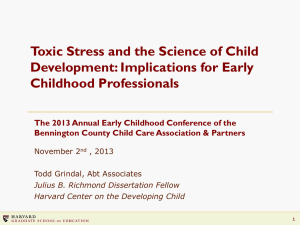The Adolescent Brain: Still Under Construction
advertisement
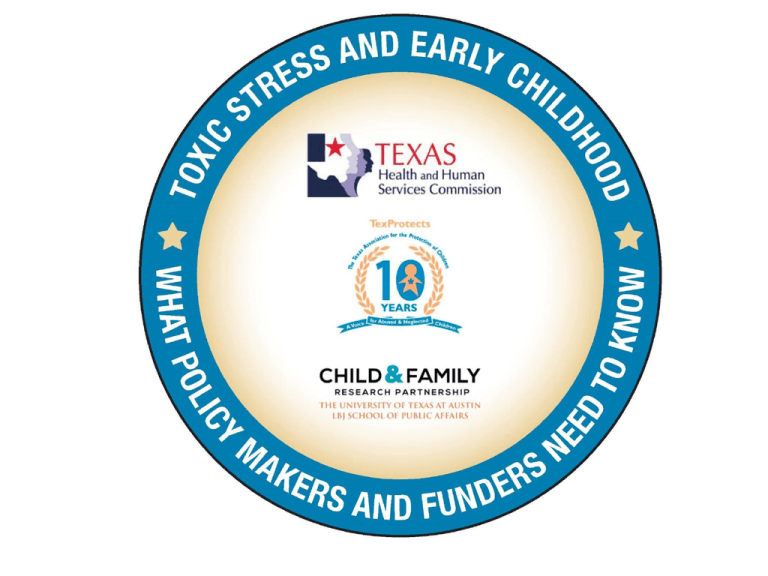
PEERING INTO THE BLACK BOX: Understanding the Link Between Significant Adversity or Violence in Childhood and Poor Adult Outcomes ? Andrew Garner, M.D., Ph.D., F.A.A.P. University Hospitals Medical Practices, and Associate Clinical Professor of Pediatrics, Case Western Reserve School of Medicine, and Chair, AAP Leadership Workgroup on Early Brain and Child Development My 3 Objectives For Today • Explain how toxic stress mediates the relationship between childhood adversity and poor adult health • Describe an “ecobiodevelopmental framework” and list its advantages • Discuss the public health implications and potentially lifelong consequences of toxic stress Critical Concept #1 Life-Course Science Experiences in childhood (both good and bad) are strongly associated with behaviors, health and economic productivity … … DECADES LATER! ACE Categories Women Men (n=9,367) (n=7,970) 13.1% 7.6% 27.0% 29.9% 24.7% 16.0% • Abuse – Emotional – Physical – Sexual • Household Dysfunction – Mother Treated Violently 13.7% – Household Substance Abuse 29.5% – Household Mental Illness 23.3% – Parental Separation or Divorce 24.5% – Incarcerated Household Member 5.2% • Neglect* – Emotional 16.7% – Physical 9.2% * Wave 2 data only (n=8,667) Total (17,337) 10.6% 28.3% 1:4! 20.7% 11.5% 23.8% 14.8% 21.8% 4.1% 12.7% 26.9% 1:4! 19.4% 23.3% 4.7% 12.4% 10.7% 14.8% 9.9% Data from www.cdc.gov/nccdphp/ace/demographics ACEs Impact Multiple Outcomes Smoking Alcoholism Promiscuity Relationship Problems High perceived stress Married to an Alcoholic Difficulty in job performance Poor SelfRated Health Hallucinations High Perceived Depression Obesity General Health and Sleep Risk of HIV Social Functioning Disturbances Risk Factors for Mental Common Diseases Health Memory Disturbances Poor Perceived ACEs Illicit Drugs Anxiety Health IV Drugs Panic Reactions Prevalent Sexual Multiple Somatic Poor Anger Health Diseases Symptoms Control Cancer Liver Disease Teen Paternity Fetal Death Skeletal Chronic Lung Teen Unintended Fractures Disease Pregnancy Pregnancy Sexually Early Age of Ischemic Heart Disease Sexual Dissatisfaction Transmitted First Diseases Intercourse Linking Childhood Experiences and Adult Outcomes Childhood Adversity Poor Adult Outcomes ? Developing a Model of Human Health and Disease How do you begin to define or measure the ecology? What are the mechanisms underlying these well-established associations? Life Course Science Early childhood ecology strongly associates with lifelong developmental outcomes Defining Adversity or Stress • How do you define/measure adversity? • Huge individual variability – Perception of adversity or stress (subjective) – Reaction to adversity or stress (objective) • National Scientific Council on the Developing Child (Dr. Jack Shonkoff and colleagues) – Positive Stress – Tolerable Stress – Toxic Stress Based on the REACTION (objective physiologic responses) Defining Adversity or Stress • Positive Stress – Brief, infrequent, mild to moderate intensity – Most normative childhood stress • Inability of the 15 month old to express their desires • The 2 year old who stumbles while running • Beginning school or daycare • The big project in middle school – Social-emotional buffers allow a return to baseline (responding to non-verbal clues, consolation, reassurance, assistance in planning) – Builds motivation and resiliency – Positive Stress is NOT the ABSENCE of stress Defining Adversity or Stress • Toxic Stress – Long lasting, frequent, or strong intensity – More extreme precipitants of childhood stress (ACEs) • Physical, sexual, emotional abuse • Physical, emotional neglect • Household dysfunction – Insufficient social-emotional buffering (Deficient levels of emotion coaching, re-processing, reassurance and support) – Potentially permanent changes and long-term effects • Epigenetics (there are life long / intergenerational changes in how the genetic program is turned ON or OFF) • Brain architecture (the mediators of stress impact upon the mechanisms of brain development / connectivity) Critical Concept #2 EPIGENETICS •“Above the genome” •Change in gene expression/no change in DNA sequence •Larger revolution in genomic science • OLD VIEW = STATIC; NEW VIEW = PLASTIC (environ. input) •Complex set of SWITCHES • Some are: Master; Dynamic; Programmed Early and Stabile “Genes may load the gun, but the environment pulls the trigger” “Epigenetics: NOT your parents’ genome!” Impact of Early Stress MATERNAL TOXIC STRESS STRESS NEWBORN HPA reactivity and salivary cortisol levels methylation of the FETAL glucocorticoid (GC) receptor gene brain expression of the GC receptor Developing a Model of Human Health and Disease Biology Physiologic Adaptations and Disruptions Life Course Science Through epigenetic mechanisms, the early childhood ecology becomes biologically embedded, influencing how/which genes are used Critical Concept #3 Developmental Neuroscience: • Brain Architecture is experience dependent (individual connections or “synapses” and complex circuits of connections or “pathways” are both dependent upon activity) • Ecology (environment/experience) influences how brain architecture is formed and remodeled (plasticity) • Diminishing cellular plasticity limits remediation • Early childhood adversity -> vicious cycle of stress (differential maturation) • Early experiences lead to potentially permanent alterations in brain architecture and functioning Two Types of Plasticity • Synaptic Plasticity – – Variation in the STRENGTH of individual connections – “from a whisper to a shout” – Lifelong (how old dogs learn new tricks) • Cellular Plasticity – – Variations in the NUMBER (or COUNT) of connections – “ from one person shouting to a stadium shouting” – Declines dramatically with age (waning by age 5) Asynchronous Brain Maturation Prefrontal Cortex Amygdala (the “OFF” switch) (the “ON” switch) Cold Cognition Judgmental Reflective Calculating Think about it Biological maturity by 24 Hot Cognition Emotional Reactive Impulsive Just do it Biological maturity by 18 Adapted from Ken Winters, Ph.D. Impact of Early Stress CHILDHOOD TOXIC STRESS STRESS Hyper-responsive stress response; calm/coping Chronic “fight or flight;” cortisol / norepinephrine Changes in Brain Architecture Developing a Model of Human Health and Disease Biology Physiologic Adaptations and Disruptions Life Course Science Declining plasticity in the developing brain results in potentially permanent alterations in brain functioning and development Eco-Bio-Developmental Model of Human Health and Disease Biology NOT: “What’s WRONG with you?” Physiologic Adaptations and Disruptions The Basic Science of Pediatrics BUT: “What’s HAPPENED to you?” Life Course Science Ecology Becomes biology, And together they drive development across the lifespan Critical Concept #4 Epigenetics Physiology of Stress Neuroscience The Science of Early Brain and Child Development Education Health Economics One Science – Many Implications The critical challenge now is to translate game-changing advances in developmental science into effective policies and practices for families w/ children to improve education, health and lifelong productivity Advantages of an EBD Framework • Though grounded in developmental science, the simplicity of the EBD framework may promote understanding as well as support for translation (early investments are the right thing to do biologically) • Psychosocial stressors and other salient features of the ecology are every bit as biological as nutrition or lead (no distinction between mental and physical health, just healthy vs. unhealthy development) • Emphasizes the dimension of time – to reflect the ongoing, cumulative nature of benefits and threats to health, educational success, and economic productivity Development results from an ongoing, re-iterative, and cumulative dance between nurture and nature Experience Protective and Personal (versus Insecure and Impersonal) Brain Development Alterations in Brain Structure and Function Epigenetic Changes Alterations in the Way the Genetic Program is Read Behavior Adaptive or Healthy Coping Skills (vs. Maladaptive or Unhealthy Coping Skills) Adapted from: Helping Foster and Adoptive Families Cope with Trauma Advantages of an EBD Framework • Underscores the need to improve the early childhood ecology in order to: – Mitigate the biological underpinnings for educational, health and economic disparities – Improve developmental/life-course trajectories • Changing the early childhood ecology will require a public health approach/collaboration (Rishi Manchanda) • Highlights the pivotal role of toxic stress – Not just “step on the gas” or enrichment (ed model) – But “take off the brake” by treating, mitigating or immunizing against toxic stress (med model; not new!) Reinventing the Wheel All over again? Models Maslow’s Hierarchy of Needs (Theoretical - 1943) America’s Promise Alliance (Evidence-based) ASCD’s Whole Child Education (Implementation) Self-Actualization Need to know, explore and understand An effective education Each student is actively engaged in learning Esteem Need to achieve and be recognized Opportunities to contribute Love/Belonging Need for friends Caring adults and family Each student has access to qualified, caring adults Safety/Security Need to feel secure and safe from danger Safe places Each student learns in a physically and emotionally safe environment Physiological Need to satisfy hunger, thirst, sleep A healthy start Each student enters school healthy Needs Each student has numerous opportunities to demonstrate achievement Release the BRAKE … before building SKILLS! SE Buffers Toxic Stress Protect the Brain Build New Skills Maladaptive Skills Adaptive Skills Critical Concept #5 Yin/Yang of Early Childhood: - Protect the Brain (Med) - Build New Skills(Ed) Linking Childhood Experiences and Adult Outcomes Childhood Adversity Poor Adult Outcomes Toxic Stress Epigenetic Modifications Disruptions in Brain Architecture Behavioral Allostasis The BIG Questions are… Since TOXIC STRESS mediates the association between ACE exposure and poor adult outcomes, it raises the following BIG questions: • Are there ways to: – treat, – mitigate, and/or – prevent (immunize against?) toxic stress? • If so, is there a mismatch between: – what we KNOW … and … – what we actually DO? Addressing Toxic Stress • Indicated treatments – Consequences are Biological Mal-adaptations (“what’s wrong with you,” vs “what’s happened to you”) – PCIT, CPP, and TF-CBT are evidence-based – Efficacy linked to age / chronicity (brain plasticity) – REACTIVE – mal-adaptations are happening! – ACCESS – interventions must be local •More providers / better reimbursement / advocacy •Need a universal but local platform (Medical homes? Schools?) – Better coordination / communication between silos www.aap.org/traumaguide Addressing Toxic Stress • Secondary / Targeted Preventions – Focused, targeted interventions for those deemed to be “at high” or the “highest risk” – Home Visiting Programs (NFP, PAT, Child First, etc.) – Parenting Programs (PPP, Nurturing Parenting, Legacy) – More likely to minimize “biological disruptions” and yield a positive ROI – Still issues with stigma; numbers of/access to providers/programs – Who is “at high risk?” Requires screening (Not perfect! No ‘OMNI-screen! Child vs Family? Dysfunction vs Risk?) Addressing Toxic Stress • Primary / Universal Prevention – Proactive, universal interventions to make stress positive, or tolerable instead of toxic – Acknowledges that preventing all childhood adversity is impossible and even undesirable – Actively building resiliency (“immunizing” through positive parenting, 7Cs, promoting optimism, formalized social-emotional learning) – SE Buffers allow the physiologic stress response to return to baseline •Parenting/Caregiving skills for younger children •SEL skills for older children (www.casel.org) Critical Concept #6 SOCIAL-EMOTIONAL SKILLS… (a.k.a – Affect Regulation, Non-Cognitive Skills, Mindfulness) …Are learned (they can be modeled, nurtured, taught, practiced, and reinforced) …Effectively buffer against toxic stress (by helping to turn off the physiologic stress response) …Increase test scores (an average of 11 points by meta-analysis!) Parenting as Primary Prevention • Promoting PARENTING SKILLS in the first 1000 days – Parenting is personal – makes pediatricians NERVOUS! – “Positive/Nurturing/Supportive” Parenting – A Poor investment? YES!! • Are parenting skills “TEACHABLE?” What is “OK?” • Is there a “CEILING EFFECT” on returns? – Or the “GOLD STANDARD?” • Shouldn’t SAFE, STABLE, and NURTURING RELATIONSHIPS be THE reference point (NOT routine, general, or control populations) • Significant Challenges: • Define what the basic, BIOLOGICAL NEEDS of children are • Utilize a TWO GENERATION APPROACH to meet those needs • Utilize a PUBLIC HEALTH APPROACH to match the FAMILY’S NEEDS with the indicated, local services Social-Emotional Safety Nets A Public Health Approach to “Toxic Stress” Universal Primary Preventions AG “Plus” (ROR / PFR / BF Grid) Consistent messaging (CTC) No identification No stigma Ceiling effects = Limited evidence base Targeted Interventions (for those “at risk”) Home visiting (NFP/PAT) Parenting programs (Legacy/PPP) Early Intervention (Ideally!) Less ceiling=More evidence Requires screening Issues with stigma ALL are necessary – NONE are sufficient! Evidence-Based Treatments (for the symptomatic) PCIT; TB-CBT; Pharmacotx Treatment works! Screening / stigma / access The BIG Questions are… Since TOXIC STRESS mediates the association between ACE exposure and poor adult outcomes, it raises the following BIG questions: • Are there ways to: – treat, – mitigate, and/or – prevent toxic stress? YES! • If so, is there a mismatch between: – what we KNOW … and … – what we actually DO? Public Health Implications • What we DO: – 95% of the trillions of dollars that we spend on health is on treatment and NOT prevention • What we KNOW: – That 70% of early deaths are preventable, with… – The majority (40% overall) due to behavioral patterns that lead to chronic disease. – Is this Behavioral Allostasis due to toxic stress? McGinnis, Williams-Russo and Knickman, 2002 Proximal Causes of Death: Chronic Disease Acute causes of death are the exception, not the rule Distal Causes of Death: Unhealthy Lifestyles If these unhealthy lifestyles are manifestations of behavioral allostasis, a FUNDAMENTAL cause of death is TOXIC STRESS! • By 2030, 90% of the morbidity in high income countries will be due to NCDs (NonCommunicable Diseases • NCDs are related to unhealthy behaviors (overeating/inactivity, smoking, alcohol, and substance abuse) How/When do those automatic processes form in the first place!? Critical Concept #7 Do we continue to treat disease, the unhealthy lifestyles that lead to disease, or the TOXIC STRESS that leads to the adoption of unhealthy lifestyles?? Developing a Shared “VISION” Toxic Stress It’s like a snake! It’s like a straw fan! It’s like a tree trunk! SUMMARY •What is Toxic Stress? –A physiologic stress response that is excessive or prolonged (reflects an inability to “turn it off”) –Results in potentially permanent changes in: •Gene expression (epigenetics) •Brain development (neuroscience) •Behavior (allostasis) SUMMARY •Why should we care? –Toxic stress is a MEDIATOR between early childhood adversity and less than optimal outcomes in learning, behavior and health –Understanding the BIOLOGY underlying these well established associations opens up new opportunities for primary prevention and early intervention Linking Childhood Experiences and Adult Outcomes Childhood Adversity Poor Adult Outcomes Toxic Stress Behavioral Allostasis Epigenetic Modifications Maladaptive behaviors Disruptions in Brain Architecture Non-communicable Diseases Improve caregiver/community capacity to prevent or minimize toxic stress (e.g. – efforts to promote the safe, stable and nurturing relationships that turn off the physiologic stress response) Improve caregiver/community capacity to promote healthy, adaptive coping skills (e.g. - efforts to encourage rudimentary but foundational SE, language, and cognitive skills ) SUMMARY •What can we do about it? – EDUCATION – for providers, trainees, families, the general public and business/philanthropic communities (re: science, TS, and EBD frame) – MESSAGING – be a “convener” (ala CTC); develop a shared “vision” locally to support a public health approach towards toxic stress – ADVOCACY – partner with like-minded stakeholders to “incentivize” wellness/relational health, population health, and long-term outcomes – RESEARCH – basic (non-invasive biomarkers, personalized med), clinical (standardized screens – not just for the child, but the family; not just for dysfunction, but those at risk), and translational (medical homes, schools, communities are integrated vertically and horizontally) – PRACTICE TRANSFORMATION – promoting wellness (over chronic/acute care) and supporting families (PPP, Family Safe Zones) Since there are known, established ways to treat, mitigate and even prevent toxic stress, WHY ARE WE NOT DOING THEM?! - “They cost too much” or “TS is not my concern” When kids don’t fulfill their potential, we ALL lose - “Defensiveness” (“It’s not MY fault” or “It’s THEM!”) Toxic stress is not restricted by race, wealth, zip code - “Too complicated” The biology suggests that it is all about relationships - “Too hard” 1) understand the science, 2) advocate for a public health approach, 3) develop a shared language/vision CONCLUSION: It is easier to build strong children than to repair broken men. Frederick Douglass Q&A Following Q&A, please transition to the Legislative Conference Center (E2.002) for lunch and afternoon presentations. Please visit http://texprotects.org/conference/toxicstress for presentation slides
